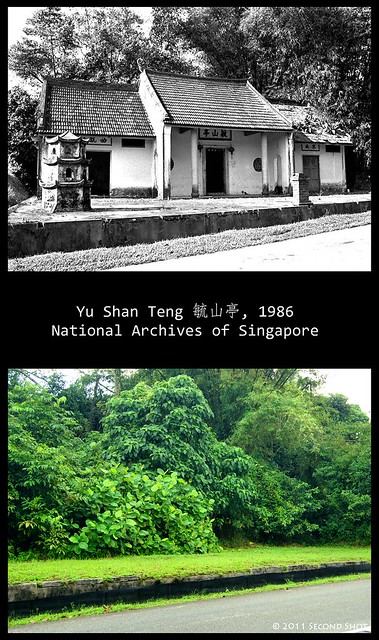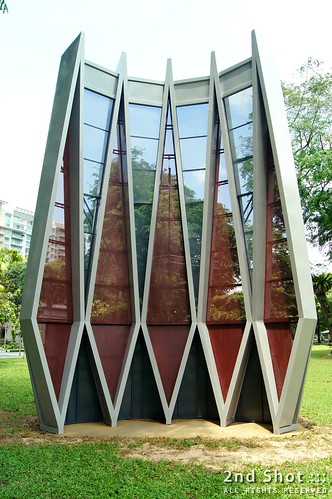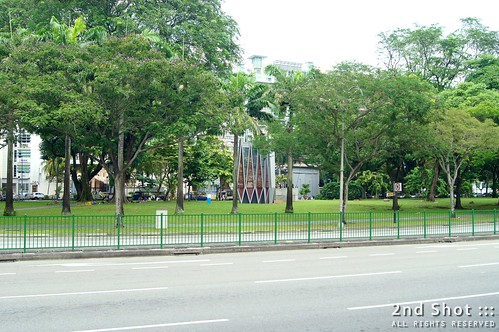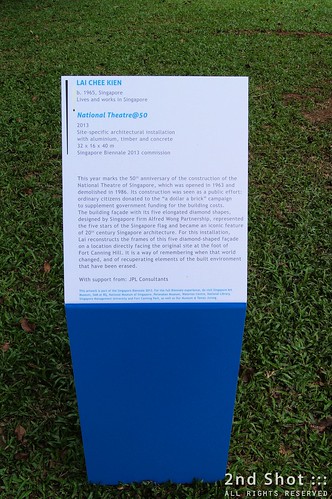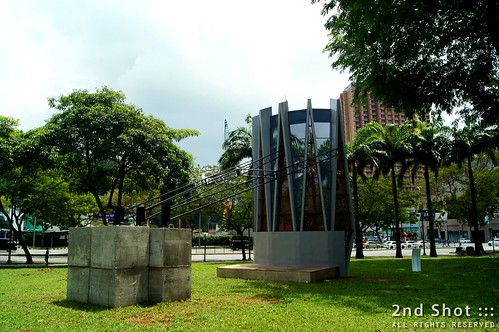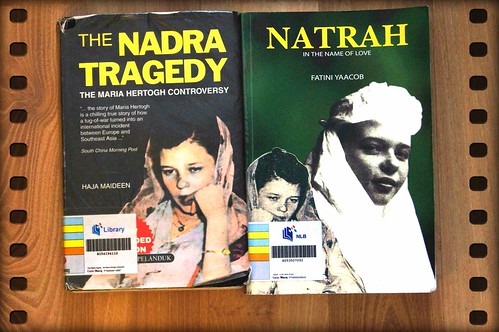This is a continuation of
Part 1.
The group left Yin Fo Fui Kun Cemetery for our next destination via Blk 32 Holland Close where we were told the MP from Tanjong Pagar GRC (i.e. Chan Chun Sing) have his "Meet the People Session"; none of us could figure out the geographical wisdom of placing Buona Vista (not Queenstown which is another division under the GRC) under Tanjong Pagar and to add to the confusion, Eu Chai pointed out Buona Vista used to be under Holland-Bukit Panjang GRC! We passed by the pyramidal roof
Queenstown Lutheran Church where Eu Chai spent his kindergarten years and observed the facade remain largely unchanged through the years.
Our destination is Commonwealth Crescent Neighborhood Centre which comprised of shop units arranged around a quadrangle and itself surrounded by blocks arranged in a circular manner much like a walled village. The highlight here is Sin Palace Hair Dressing and Beauty Saloon managed by Mr Ong Choon Kwee, one of Singapore's last experts in the traditional art of ear cleaning. I love ear cleaning within the comfort of home and wondered how the experience is like outside. According to
My Queenstown Heritage Trail booklet, after the haircut:
Next, he will use his assortment of tools, ranging from tweezers, brushes and picks, to fish out the ear wax. Then a small fluffy brush is swished around the inner ear before he wipes his customer's eye and nose. Thereafter, the tongue is scrapped gently with a special knife to remove any white coating.
Kudos to the tour organizers who asked for permission tactically, without revealing the actual number of participants, to allow the group to enter the saloon. There was a customer inside and what a shock he must have felt as we took turns to squeeze into the confined space behind the chairs for our shots. Outside the saloon, we met Mr Lim Thiam Choo from Queenstown Poh Piah, another pioneer business from the neighborhood. Interestingly they are in the niche business of selling pohpiah skin. The elderly Lim retired in 2011 and his eldest son has carried on his tradition.
![Media Preview - Commonwealth & Holland Village Heritage Tour]() |
| Sin Palace Hair Dressing Saloon - 乐宫冷气理发院. I'm not sure why 乐宫 becomes Sin Palace, is "Sin" a dialect reading of 乐? Behold, you see our group's reflection in the glass. |
![Media Preview - Commonwealth & Holland Village Heritage Tour]() |
| To call this old-school (and the customer surprised) will not be an understatement. I love the tap in front of the saloon chair. |
Singapore's first flatted factory at Commonwealth Drive, a short way away, was our next stop. Inaugurated on 30 May 1965, the success of this pilot project had the Economic Development Board (EDB) go on to build 38 more flatted factories across the country. The star here is not the modern-looking building but Madam Noorsia Binte Abdul Gani who has been living with her husband and four children in Commonwealth since they relocated from Toa Payoh 31 years ago. She was a former employee of Wing Heng, an electronics company, at the flatted factory. As the organizers and guide repeatedly emphasized, the location of the light industry factory in Queenstown meant a ready supply of labour and encouraged women to enter the workforce. For Madam Noorsia, her house was nearby and so was the children's school; it was convenient for her to fetch the kids and prepare meals for the family.
![Media Preview - Commonwealth & Holland Village Heritage Tour]() |
| The first flatted factory managed by Mapletree Investments today looking surprisingly modern |
![Media Preview - Commonwealth & Holland Village Heritage Tour]() |
| Madam Noorsia, in what used to be her children's school, recounting her experience living and working in the Commonwealth Neighborhood |
At
MOE Heritage Centre where Madam Noorsia recounted her experience, there was special arrangement to have a tour within a tour. Opened in September 2011, the Heritage Centre took over what was New Town Primary School which in turn absorbed what was Permaisura Primary School in one-half of the compound. And so Eu Chai handed us over to the MOE staff but not his mike, as he jokingly acknowledged the teachers had no need for any assisted device to project their voice. We were broken up into two groups and guided by docents who are retired principals. The galleries that showcase Singapore's education story from the early 19th century (note: photography not allowed inside) was a brief respite from the heat outdoors but the best had to be the free snacks and gift (notebook with
PETS Coursebook cover) for us, normally reserved for teachers on guided tours. In fact we ended up grabbing last year's SG50 "Good Morning 'Cher" goodie bag from them as they dished out the surplus. We ended with a
group shot at the lobby.
![Media Preview - Commonwealth & Holland Village Heritage Tour]() |
| MOE Heritage Centre is opened to public every Friday and from Monday to Friday during the school holidays |
![Media Preview - Commonwealth & Holland Village Heritage Tour]() |
| The garden where I saw rice, kangkung, chye sim and sweet potato being planted |
![Media Preview - Commonwealth & Holland Village Heritage Tour]() |
| With Compliments from MOE Heritage Centre |
On the way to visit the VIP block, we stopped for a photo op at Blk 85 / 86 Commonwealth Close. This would be a nondescript grassy slope between two blocks if not for the picture Choo Lip Sin, one of My Community's volunteers, was going to show us - a beaming Lee Kuan Yew captured at the same spot due to, presumably, the success of HDB's "Home Ownership for the People" scheme that was launched in the 1960s with Commonwealth as the first precinct.
![Media Preview - Commonwealth & Holland Village Heritage Tour]() |
| What is Lip Sin holding in his file? Here is the close up of the content. |
The VIP block is so named because one can enjoy a panoramic view of Queenstown and hence the perfect place to bring in foreign dignitaries in the 1960s and 1970s to showcase Singapore's success in public housing. One lady resident recalled the impromptu visit by Prince Philip, the Duke of Edinburgh, in 1965. As we listened to her account of the visit (she was a kid at that time), we can't help but contrast with the
visit by the Duke's grandson and granddaughter-in-law in 2012 also in Queenstown (they visited the Strathmore area) where activities were "staged" to the amusement of netizens. Block 81 the VIP block and the neighboring Block 82 and 83 gave the neighborhood the colloquial name
Chap Lak Lao (Hokkien: 16th storey). As we made our way up to the 16th floor
corridor, we had a demonstration of the range of the wireless receiver. We could still hear Eu Chai who chose to remain at the
playground below the block.
![Media Preview - Commonwealth & Holland Village Heritage Tour]() |
| The lady resident recounted the visit by Prince Philip |
![Media Preview - Commonwealth & Holland Village Heritage Tour]() |
| The panoramic view from the top of Blk 81 |
![Media Preview - Commonwealth & Holland Village Heritage Tour]() |
| From the lift landing looking across Queensway, a forested patch beckons us |
The VIP block has such commanding presence due to the number of floors and the building situated on high ground. To get to Ridout Tea Garden, our next stop, we had to descend down a flight of steps to Queensway. We were told by Eu Chai the road had been raised from the last few steps actually going
up; and also widened, from the bizarre zig-zag
boundary fence of the former Baharuddin Vocational Institute compound due to road reclamation of the school compound.
![Media Preview - Commonwealth & Holland Village Heritage Tour]() |
| An oddity - steps leading up to the pavement due to the raised level of the road |
So we
trooped to Ridout Tea Garden. No, we weren't there for the McDonald's though we did
pass through it to get to our next destination and being told in no uncertain terms by Eu Chai this was our last stop to answer nature's call before the end of the tour. Must I add the feeling of air-con was refreshing from the late morning sun outside and the soft drinks (need to pay, of course) a life saver for some people? Formerly Queenstown Japanese Garden, the first Japanese-themed community garden in Singapore, it was opened in 1970 as recreational facility for residents in Queenstown. Unfortunately it was burnt down on 26 June 1978 from a huge blaze originating from a furniture shop in the garden. In fact, one can see a
L-shaped scorched red-bricked wall outside McDonald's, the remnant from the 1978 fire, so we were told. From the ashes of the former garden, Ridout Tea Garden comprising a pavilion, tea kiosk and Japanese-styled garden was built in 1980.
![Media Preview - Commonwealth & Holland Village Heritage Tour]() |
| The burnt red-bricked wall that reminds us of the 1978 fire |
![Media Preview - Commonwealth & Holland Village Heritage Tour]() |
| Ridout Tea Garden behind McDonald's, the Japanese-styled garden is obliterated? |
After Ridout Tea Garden and making our way through
FarEastFlora to Ridout Road, we found ourselves outside Queenstown boundary in a forested area with
good class bungalows (GCB) hidden behind fences and trees. Like Eu Chai who had no idea such a world existed during his childhood years staying at Margaret Drive, many Queenstown residents are probably ignorant what lies underneath the forested patch visible from Blk 81 the VIP block. Those who can afford the bungalows do value the privacy and exclusivity. I do not recall seeing any residents in the sprawling estate other than a
yellow Porsche that left us in the
dust.
One such bungalow is
35 Ridout Road, the first GCB on your right as you exit FarEastFlora. We were told this
desolate bungalow was sold at a staggering ballpark of S$95 million! According to the
news, the sprawling 73,277 sq ft freehold site was a "trustee sale due to a court order arising from the resolution of a dispute in the family of the late property tycoon, Chow Cho Poon". The site is so big that it can be subdivided into four smaller GCB plots.
![Media Preview - Commonwealth & Holland Village Heritage Tour]() |
| The original two-storey bungalow at 35 Ridout Road |
The Ridout and Pierce Road area is also home to two members of the diplomatic corps. 23 Ridout Road, a conserved GCB designed by architect Frank W Brewer with exposed bricks and textured plasterwork, is residence for the Ambassador from the Royal Dutch Embassy. The Residence for High Commissioner of India is at 2 Pierce Road. India House, as it is popularly known, is a tropical black and white bungalow thought to be commissioned by wealthy businessman Ong Sam Leong in 1911.
![Media Preview - Commonwealth & Holland Village Heritage Tour]() |
| Residence of the Dutch Ambassador with a distinctive style inspired by the Arts and Crafts movement |
![Media Preview - Commonwealth & Holland Village Heritage Tour]() |
| An eclectic house at 2 Pierce Drive |
![Media Preview - Commonwealth & Holland Village Heritage Tour]() |
| Another black and white bungalow |
The number of surviving colonial bungalows in the area point to its history as one of the earliest of the postwar military estates built in the 1920s to accommodate the growing number of military personnel on the island; in this case Ridout Road to the north of Tanglin Barracks (also Ridley Park to the south) house married officers and their families. Even the
road names reflect our colonial heritage: Sir Dudley Ridout was General Officer Commanding of Troops in the Straits Settlement from 1915 to 1921 and Sir Frank Swettenham was Governor of the Straits Settlements between 1901 and 1904.
As we trudged on to reach our end point at Holland Road, trees line the single carriageway, shielding us from the brutal heat of the midday sun and also remind us what was there before the arrival of the colonial bungalows in the 1920s. The guides shared on the rubber trees in our midst, the vestiges of Ulu Pandan Rubber Estate that the area was once a part of. Our end took us right to the beginning of Queenstown's social history as a rubber plantation. After all, the first residents in Holland and Commonwealth were gambier and rubber planters working on land holding owned by the Chinese businessman Tan Kim Seng.
![Media Preview - Commonwealth & Holland Village Heritage Tour]() |
| Along the lonely road with vestiges of the rubber estate |
![Media Preview - Commonwealth & Holland Village Heritage Tour]() |
| At the end point |
Our Commonwealth and Holland Village heritage tour ended at 1230 sharp at the junction of Peirce Road and Holland Road. To the organizers, guides and participants who had made it this far with me, thank you!
***
If you are interested to join the free Commonwealth and Holland Village heritage tour by My Community, do check out the schedule on their
Eventbrite. As I see it, the first public tour starts from Sunday, 15 May 2016 and it has been sold out.



































